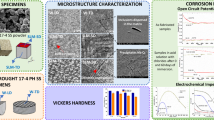We evaluate the corrosion resistance of welded joints of sintered VT1-0 titanium obtained by convection friction welding according to the results of electrochemical and gravimetric investigations in aggressive media of inorganic acids (hydrochloric and sulfuric). It is shown that corrosion-resistance characteristics of the metal of the zone of thermomechanical influence are higher than for the base metal due to the formation of a more homogeneous structure, its refining, substantial increase in the density of the compacted material (decrease in the sizes and number of pores), and the absence of segregation of additives. The prospects of application of the method of pressure welding in manufacturing the products of chemical industry from sintered titanium are confirmed.




Similar content being viewed by others
References
V. Е. Blashchuk, V. N. Zamkov, L. М. Onoprienko, G. М. Shelenkov, and V. É. Troyanovskii, “Influence of the production technology of semifinished products from AT3 titanium alloy on the corrosion resistance of welded joints,” Avtomat. Svarka, No. 1 (490), 33–35 (1994).
A. E. Kapustyan, А. V. Ovchinnikov, Т. А. Kovalenko, and А. V. Shevchenko, “Manufacture of semifinished products from titanium alloys for aerospace engineering,” Aviats-Kosmich. Tekh. Tekhnol., No. 7 (134), 107–116 (2016).
Yu. N. Kusakina and L. V. Fedorova, “Application of the concept of the life cycle of production technologies to the determination of promising directions of scientific investigations of titanium alloys,” Titan, No. 3, 50–53 (2017).
Yu. S. Ruskol, Titanium Structural Alloys in the Chemical Industries: A Handbook [in Russian], Khimiya, Moscow (1989).
V. E. Blashchuk and S. G. Polyakov, “Accelerated determination of the susceptibility of welded joints of titanium alloys to corrosion cracking,” Avtomat. Svarka, No. 6 (519), 13–16 (1996).
А. А. Trufanov, R. K. Мelekhov, О. D. Smiyan, and V. А. Sher, “Corrosion cracking of welded joints of a high-strength titanium alloy,” Avtomat. Svarka, No. 5 (446), 31–36 (1990).
О. D. Smiyan, G. М. Grigorenko, V. Е. Blashchuk, Е. I. Butkova, L. М. Onoprienko, and А. А. Trufanov, “Corrosion resistance of welded joints of AT3 titanium alloy in sulfuric acid solutions,” Avtomat. Svarka, No. 12 (441), 41–44 (1989).
G. М. Shelenkov, V. É. Troyanovskii, V. E. Blashchuk, and L. М. Onoprienko, “Corrosion resistance of welded joints of some titanium alloys,” Avtomat. Svarka, No. 4, (385), 19–20 (1985).
V. P. Leonov, V. I. Mikhailov, and I. Yu. Sakharov, “Influence of thermal cycles of different welding methods on the structure and corrosion-mechanical properties of welded joints of pseudo-α -titanium alloys,” in: Proc. of the Int. Conf. “Ti-2011” in the Commonwealth of Independent States” (Lvov, April 25–28, 2011) [in Russian], Kurdyumov Institute of Metal Physics, Ukrainian National Academy of Sciences, Kiev (2011), pp. 71–79.
V. I. Makhnenko, V. M. Shekera, and L. М. Onoprienko, “Determination of parameters of a simplified diagram of static corrosion crack resistance of pipe steels under soil corrosion,” Avtomat. Svarka, No. 10, 31–35 (2008).
V. E. Blashchuk, L. М. Onoprienko, G. М. Shelenkov, and V. É. Troyanovskii, “Salt corrosion of welded joints of AT6 alloy,” Avtomat. Svarka, No. 3, 68–69 (1990).
М. А. Langer, V. Е. Blashchuk, L. М. Onoprienko, and G. М. Shelenkov, “Salt corrosion of АТ3 alloy and welded joints,” Avtomat. Svarka, No. 10, 69–70 (1983).
Т. G. Taranova, G. М. Grigorenko, S. V. Akhonin, V. K. Sabokar’, О. М. Zadorozhnyuk, Т. G. Solomiichuk, and Е. V. Polovetskii, “Features of formation of the structural and chemical inhomogeneity in welded joints of titanium alloys of the Ti–Si–X system made by pressure welding,” in: Proc. of the Internat. Conf. “Ti-2013” in the Commonwealth of Independent States (Donetsk, May 26–29, 2013) [in Russian], Kurdyumov Institute of Metal Physics, Ukrainian National Academy of Sciences, Kiev (2013), pp. 214–220.
S. V. Akhonin, V. F. Topol’skyi, R. N. Mishchenko, I. K. Petrichenko, and É. L. Vrzhizhevskii, “The weldability and operating characteristics of VT6 titanium sheet obtained by the vacuum-arc refining and electroslag refining methods,” in: Proc. of the Int. Conf. “Ti-2006 in the Commonwealth of Independent States” (Suzdal, May 21–24, 2006) [in Russian], Naukova Dumka, Kiev (2006), pp. 44–50.
Yu. V. Chernyshova, Regularities of the Influence of the Bulk and Surface Structure on the Electrochemical Corrosion of Implants of Alloys Based on Titanium and Titanium Nickelide [in Russian], Author’s Abstract of the Candidate-Degree Thesis (Eng.), Moscow (2008).
S. Yu. Illarionov, L. D. Dobrushin, S. G. Polyakov, and G. Е. Boeva, “Increase of the corrosion resistance of welded joints of highstrength aluminum alloys by explosion cladding,” Avtomat. Svarka, No. 2, 52–55 (2005).
A. E. Kapustyan, “Manufacture of long semifinished products from sintered titanium alloys by friction welding,” Avtomat. Svarka, Nos. 3–4, 55–59 (2015).
I. M. Pohrelyuk, O. V. Tkachuk, and R. V. Proskurnyak, “Corrosion resistance of the Ti–6Al–4V titanium alloy with nitride coatings in 0.9% NaCl,” J. Miner., Met. Mater. Soc., 63 (6), 35–40 (2011).
I. M. Pohrelyuk, O. V. Ovchynnykov, A. A. Skrebtsov, B. P. Bakhmatyuk, and Kh. S. Shvachko, “Electrochemical behavior of titanium synthesized by the method of powder metallurgy in hydrochloric acid,” Fiz.-Khim. Mekh. Mater., 52, No. 2, 92–97 (2016); English translation: Mater. Sci., 52, No. 2, 246–252 (2016).
O. I. Steklov, A. A. Antonov, and S. P. Sevost’yanov, “Ensuring the integrity of welded constructions and structures during their long operation with the use of renovation technologies,” Avtomat. Svarka, Nos. 6–7 (733), 1–6 (2014).
Author information
Authors and Affiliations
Corresponding author
Additional information
Translated from Fizyko-Khimichna Mekhanika Materialiv, Vol. 54, No. 3, pp. 128–135, May–June, 2018.
Rights and permissions
About this article
Cite this article
Kapustyan, О.E., Ovchynnykov, О.V., Skrebtsov, А.А. et al. Corrosion Resistance of Welded Joints of Titanium Synthesized by the Method of Powder Metallurgy. Mater Sci 54, 430–437 (2018). https://doi.org/10.1007/s11003-018-0202-3
Received:
Published:
Issue Date:
DOI: https://doi.org/10.1007/s11003-018-0202-3




